Art As An Escape: Artist Beats Agony Of Misdiagnosed Arthritis Through Paint Therapy
Rheumatoid arthritis is an autoimmune disorder where the body’s immune system mistakenly targets and attacks its own healthy tissues. This leads to joint pain, swelling, and stiffness, potentially causing reduced red blood cell counts and inflammation in the areas surrounding the lungs and heart.

Representative image. (Photo Credit: Unsplash)
Seema Sood who is currently 53, petitioned the President of India in 2007 for euthanasia due to the unbearable pain of rheumatoid arthritis that left her bedridden and in extreme pain. About 5’9” tall, she lost weight and at one point weighed merely 36 kgs.
However, her doctor did not give up on her and tried various methods of therapy. Between one of the sessions, the doctor asked Sood to take up on painting as she used to and loved doing it.
According to Sood, things changed once she started painting again. She said, “I could almost feel its scent. My friends saw it and encouraged me to do some more works, exhibit and auction them to raise funds for my therapies.” A wall in the reception area of Fortis Mohali is dedicated to her paintings.
Dr Anil Abrol, Consultant, Department of Rheumatology, helped Sood get back to normal living and find peace in her agony. According to The New Indian Express Sood said, “The day I drew the rose, I forgot my pain. It gave me confidence to move my limbs, brought me alive and value myself.”
Dr Abrol employed painting as a therapeutic method and viewed creativity as an empowering tool. However, due to the complexities of her arthritis and years of misdiagnosis, she consistently adapted to the changing primary method of therapy.
Rheumatoid arthritis is an autoimmune disorder where the body’s immune system mistakenly targets and attacks its own healthy tissues. This leads to joint pain, swelling, and stiffness, potentially causing reduced red blood cell counts and inflammation in the areas surrounding the lungs and heart.
“Early diagnosis is paramount, particularly in the first four to six weeks. Then deformities do not develop, and the drug efficacy is high,” said Dr Abrol according to the news outlet.
The triggers can be unpredictable because it is an auto-immune disease. It can happen due to changing weather or viral infections. He suggests that people do not ignore any signs like early morning stiffness, which increases while resting and persistent joint pain.
“It starts in the 20s and 30s, women being more predisposed to it. A balanced diet, maintaining a healthy weight and avoiding smoking are important in the condition, and the key is not to ignore any symptoms,” Dr Abrol stated.
Sood complained of pain in 1986, she was advised to take painkillers and steroids as she was misdiagnosed with osteoarthritis. By 1991, her condition worsened, and she was taken off steroids after passing out one day.
An engineer graduated from BITS Pilani, felt remorseful for utilizing her family's finances excessively. In 1999, she chose to undergo surgery with the expectation of gaining mobility, and for a while, she could walk with the aid of a cane. However, in 2004, she experienced a recurrence of her condition.
Sood shares, “By then my family had consulted many specialists and spent money on therapy and medicines. We had to travel frequently between Palampur and Chandigarh. I was advised joint and hip replacement surgery, costing about Rs 10 lakh,” Seema recalls.
Due to financial constraints, encompassing the steep expenses for treatment such as physiotherapy sessions, medical staff, and medications, Seema found herself plunging deeper into despair.
In 2007, she appealed for euthanasia directly to the President.
However, Himachal Pradesh Chief Minister Prem Kumar Dhumal intervened, assuring full coverage of her medical costs by the state government.
Despite undergoing surgery in 2008, Seema continued to endure severe pain and discomfort for the subsequent seven years. It wasn't until 2014, when she encountered Dr Abrol at Fortis Mohali, that she was diagnosed with rheumatoid arthritis and received pro bono treatment. Following an extensive course of treatment, Sood began exhibiting signs of improvement.
Dr Abrol said, “When I first met Seema in 2014, such was her pain that we needed three people to make her sit. Mentally, she had given up with no backup, support or financial help. Also, her gastrointestinal system was not able to tolerate medicines.”
As Sood improved and regained confidence, he motivated her to develop a creative hobby. “The appreciation for her work really did wonders for her confidence. She has now put on some weight, gained some muscle mass and feels more in control,” Dr Abrol added.
End of Article
Subscribe to our daily Newsletter!
Videos





02:10
Raveena Tandon addresses CONTROVERSIAL statements regarding Khushi Kapoor and Agastya Nanda in The Archies

02:27
iQOO 12 5G | Glimpse of Exciting Leaks! | Funtouch OS Android 14, Qualcomm Snapdragon 8Gen3 & More

02:15
OnePlus 12 Design & Looks | OnePlus 12 Latest Updates | OnePlus 12 Colour Available | Gadget Times

03:53
Urfi Javed Flaunts her Topless Style | Jennifer Mistry's HEARTWARIMNG note for TMKOC

04:45
'World Used Kashmir Against India': What EAM Said On J&K's Art 370| Page From Times Now Archive














